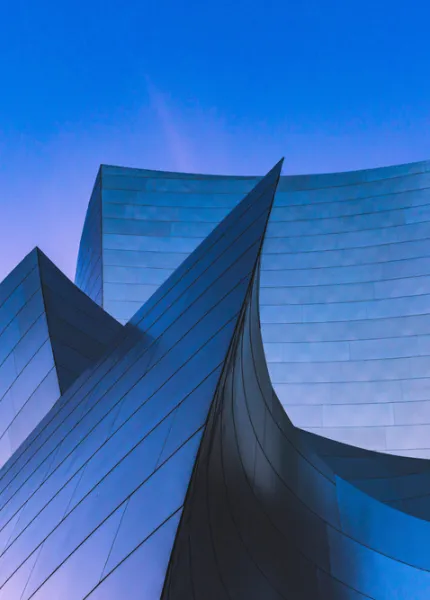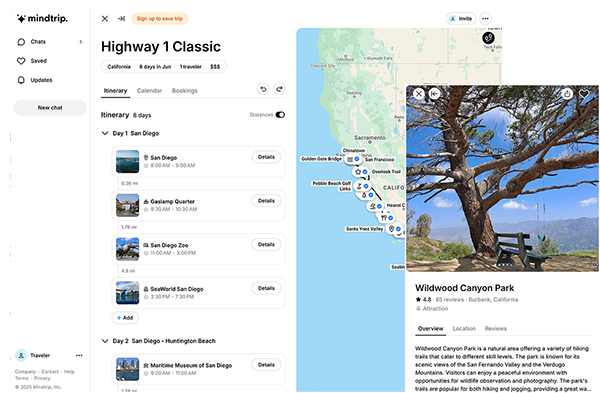Architecture Gems
Marvel at mid-century modern masterpieces, Craftsman classics, Mission Revival works, and other landmark buildings.

Trip Itinerary Overview
13 stops on this route
Stop 1
Getty Center, Los Angeles
Stop 2
Stahl House, Los Angeles
Stop 3
Hollyhock House, Los Angeles
Stop 4
Walt Disney Concert Hall
Stop 5
The Broad Contemporary Art Museum
Stop 6
Gamble House, Pasadena
SPOTLIGHT Stop 7
Mission Inn Hotel & Spa
Stop 8
Elvis Honeymoon Hideaway
Stop 9
Parker Palm Springs Hotel
Stop 10
Sunnylands
SPOTLIGHT Stop 11
Havana Kitchen
Stop 12
The Salk Institute
Stop 13
California Tower - Balboa Park, San Diego
Car & RV Rentals
Trusted car & RV rental companies make your trip much easier
Discover More of California
Stop 1: Getty Center, Los Angeles
Perched in the hills above the Westside of Los Angeles in Brentwood, the Getty Center looks like an elevated modernist city, its pearl-beige walls as compelling as the art collection they enclose. Park your car and take a five-minute tram ride to this glorious six-building compound with expansive city-skyline and ocean views. Designed by Richard Meier as a tribute to culture and landscape, the Getty was constructed with 16,000 tons of Italian travertine. You’ll need half a day to take in the hundreds of pre-20th-century European paintings, drawings, illuminated manuscripts, decorative arts, and photographs, as well as the outdoor sculpture gardens and fountains.
Planning Resources
- The Getty Center – http://www.getty.edu/visit/center/plan/
Stop 2: Stahl House, Los Angeles
In the Hollywood Hills, where mansions overlook the glittering city below, the cliff-perched Stahl House is a shining example of uber-modern minimalism by architect Pierre Koenig. Built in 1959, the rectangular residence has three sides made of glass, which capitalize on its cityscape view. The house became the posterchild for modern architecture during the 20th century, thanks to the work of renowned architectural photographer Julius Shulman. With a tour ticket (reserve in advance), you can view the streamlined interior, a popular location for film and fashion shoots.
Planning Resources
- The Stahl House – https://stahlhouse.com/
Stop 3: Hollyhock House, Los Angeles
Tucked between Little Armenia and Thai Town in Los Angeles, this National Historic Landmark was designed by Frank Lloyd Wright for oil heiress Aline Barnsdall in 1919. Described as a harbinger of California Modernism, Hollyhock House reflects a melting pot of design influences including Mayan, Aztec, Asian and Egyptian. (Lloyd Wright called the style “California Romanza.”) The house is constructed solely of geometric cast-concrete "textile blocks" and is adorned with Barnsdall’s favorite flower, the hollyhock. Book ahead to join a docent-led tour.
Planning Resources
- Hollyhock House – https://www.barnsdall.org/hollyhock-house
Stop 4: Walt Disney Concert Hall
Located in downtown Los Angeles, this gleaming, stainless-steel edifice was inspired by architect Frank Gehry’s love for sailing. Walk the stairways and catwalks that lead up to and around its multiple exterior walls, which curve like billowing sails. Home to the Los Angeles Philharmonic, the Walt Disney Concert Hall is much more than a state-of-the-art music venue. Take a self-guided or guided tour (both complimentary) to explore the garden, where you’ll enjoy sweeping city views, and the rose-shaped Lillian Disney Fountain, a tribute to the woman who made the concert hall possible.
Planning Resources
- Walt Disney Concert Hall – http://www.laphil.com/philpedia/about-walt-disney-concert-hall
Stop 5: The Broad Contemporary Art Museum
This 120,000-square-foot contemporary art museum in downtown Los Angeles is visually captivating with its unusual geometric shape and honeycomb-patterned exterior. What began as Eli and Edythe Broad’s small collection of postwar and contemporary art is now a treasure trove of more than 2,000 pieces, including classic works by artists like Ed Ruscha, John Baldessaire, and Jeff Koons. In addition to the two floors of exhibition space, architecture firm Diller Scofidio + Renfro—known for designing Boston’s Institute of Contemporary Art and renovating New York City’s Lincoln Center—devised a large collection storage space, dubbed “the vault,” to be a central feature of the $140 million building. Its “veil” exterior lets natural light flow inside while protecting the art from direct sun. While admission is free, you still need a ticket for your specific day and time, which can be ordered in advance online.
To find out about more nearby destinations for lovers or art—or film, or beaches, or anything else the city has to offer—visit the California Welcome Center - Los Angeles.
Planning Resources
- The Broad – http://www.thebroad.org
Stop 6: Gamble House, Pasadena
Situated on a leafy, meticulously manicured private street in upscale Pasadena, The Gamble House is an iconic example of early 20th-century Craftsman architecture. Built in 1908 by Mary and David Gamble (of Proctor & Gamble fame), the house was designed by architect brothers Charles and Henry Greene, the masterminds behind the notable California bungalow style. Take a docent-led tour of this three-story wooden mansion and swoon over exquisitely crafted cabinetry, paneling, and furniture designed by the inventive architect brothers.
Planning Resources
- Gamble House – https://gamblehouse.org/
- Visit Pasadena – http://www.visitpasadena.com/
Stop 7: Mission Inn Hotel & Spa
Stay the night at the Mission Inn Hotel & Spa, the country’s largest and grandest Mission Revival–style building.
Stop 8: Elvis Honeymoon Hideaway
Amid the white-walled mansions of Palm Springs’ Movie Colony neighborhood, Elvis’ Honeymoon Hideaway is the 5,000-square-foot residence where The King and Priscilla enjoyed postnuptial bliss in 1967. Constructed in four concentric circles and without a single square room, this home was featured as “The House of Tomorrow” in a 1962 Look magazine centerfold and is still one of the more notable examples of Palm Springs’ midcentury modern character. Nab tickets to check out the 64-foot built-in banquette sofa, straight-out-of-The-Flintstones rock walls, and other era-defining elements.
Planning Resources
- Elvis’ Honeymoon Hideaway – https://moderntourspalmsprings.com/elvis-presley-honeymoon-hideaway-house-palm-springs/
Stop 9: Parker Palm Springs Hotel
This chic hotel opened in 1959 as California’s first Holiday Inn, and today the groovy retro vibe is cooler than ever. Given a $27 million makeover by interior designer Jonathan Adler, the Parker Palm Springs stands as one of the “it” spots for seclusion-seeking celebs who love the privacy of its high white walls, dense hedges, and off-the-grid entrances. Grab a table on the bright terrace at Norma’s, known for its decadent all-day breakfast menu, then explore the meandering gardens and grounds to soak up the property’s mid-century modern panache. Or sample a flight from the curated wine list at the under-the-radar bar, Counter Reformation. Better yet, book an overnight stay in a Deluxe Room, adorned with Old Hollywood décor.
Planning Resources
- The Parker Palm Springs – https://www.parkerpalmsprings.com/
Stop 10: Sunnylands
In the Coachella Valley’s Rancho Mirage, this 200-acre estate and former home of philanthropists Walter and Leonore Annenberg is a mid-century masterpiece that also houses an impressive art collection (think Monet, Picasso, Van Gogh). Take a guided tour of the pink-roofed mansion designed by A. Quincy Jones or meander around the Sunnylands gardens and 11 man-made lakes. While you can stroll through the 1.25 miles of garden paths for no charge, you must sign up well in advance to purchase a ticket for a guided tour of the house. (It’s worth the wait.) A museum, theater, and an indoor/outdoor cafe (with stunning views of the San Jacinto Mountains) are also housed in striking glass buildings.
Planning Resources
- Sunnylands – http://www.sunnylands.org/page/418/tour-the-historic-estate
Stop 11: Havana Kitchen
Stop in Old Town Temecula for Cubano sandwiches at Havana Kitchen.
Stop 12: The Salk Institute
This historical site (and active biomedical sciences research campus) in San Diego County’s upscale La Jolla was established by Dr. Jonas Salk, the inventor of the polio vaccine, in 1960 (it was completed in 1965). Salk believed that having unobstructed views of the beautiful coastal San Diego environs would inspire the creativity of the researchers working inside his labs. Today, visitors can also savor the sweeping vistas and stunning architecture during a self-guided tour (tickets are $7.50 and must be reserved online in advance). Start at the institute’s centerpiece, a pair of six-story structures flanking a light-filled courtyard, then explore the 29-building campus, designed by architect Louis Kahn to showcase the Salk’s oceanfront perch.
Planning Resources
- The Salk Institute – https://www.salk.edu/about/visiting-salk/
Stop 13: California Tower - Balboa Park, San Diego
Dating back to the early 19th century, San Diego’s Balboa Park is one of the oldest public parks in the nation, with more than 20 art, culture, and science museums. Much of the park’s Spanish Renaissance architecture has been impeccably preserved, and while each building has its merits, the California Tower at the Museum of Us is a standout. Climb seven floors to the top of this ornate 200-foot-tall structure for a dazzling 360-degree view of the park and beyond.
Planning Resources
- Balboa Park – Tours – https://www.balboapark.org/explore/tours
- Balboa Park – https://www.balboapark.org/




















